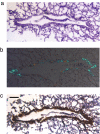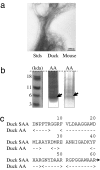Amyloidogenic potential of foie gras
- PMID: 17578924
- PMCID: PMC1894569
- DOI: 10.1073/pnas.0700848104
Amyloidogenic potential of foie gras
Abstract
The human cerebral and systemic amyloidoses and prion-associated spongiform encephalopathies are acquired or inherited protein folding disorders in which normally soluble proteins or peptides are converted into fibrillar aggregates. This is a nucleation-dependent process that can be initiated or accelerated by fibril seeds formed from homologous or heterologous amyloidogenic precursors that serve as an amyloid enhancing factor (AEF) and has pathogenic significance in that disease may be transmitted by oral ingestion or parenteral administration of these conformationally altered components. Except for infected brain tissue, specific dietary sources of AEF have not been identified. Here we report that commercially available duck- or goose-derived foie gras contains birefringent congophilic fibrillar material composed of serum amyloid A-related protein that acted as a potent AEF in a transgenic murine model of secondary (amyloid A protein) amyloidosis. When such mice were injected with or fed amyloid extracted from foie gras, the animals developed extensive systemic pathological deposits. These experimental data provide evidence that an amyloid-containing food product hastened the development of amyloid protein A amyloidosis in a susceptible population. On this basis, we posit that this and perhaps other forms of amyloidosis may be transmissible, akin to the infectious nature of prion-related illnesses.
Conflict of interest statement
The authors declare no conflict of interest.
Figures




References
Publication types
MeSH terms
Substances
Grants and funding
LinkOut - more resources
Full Text Sources
Medical

